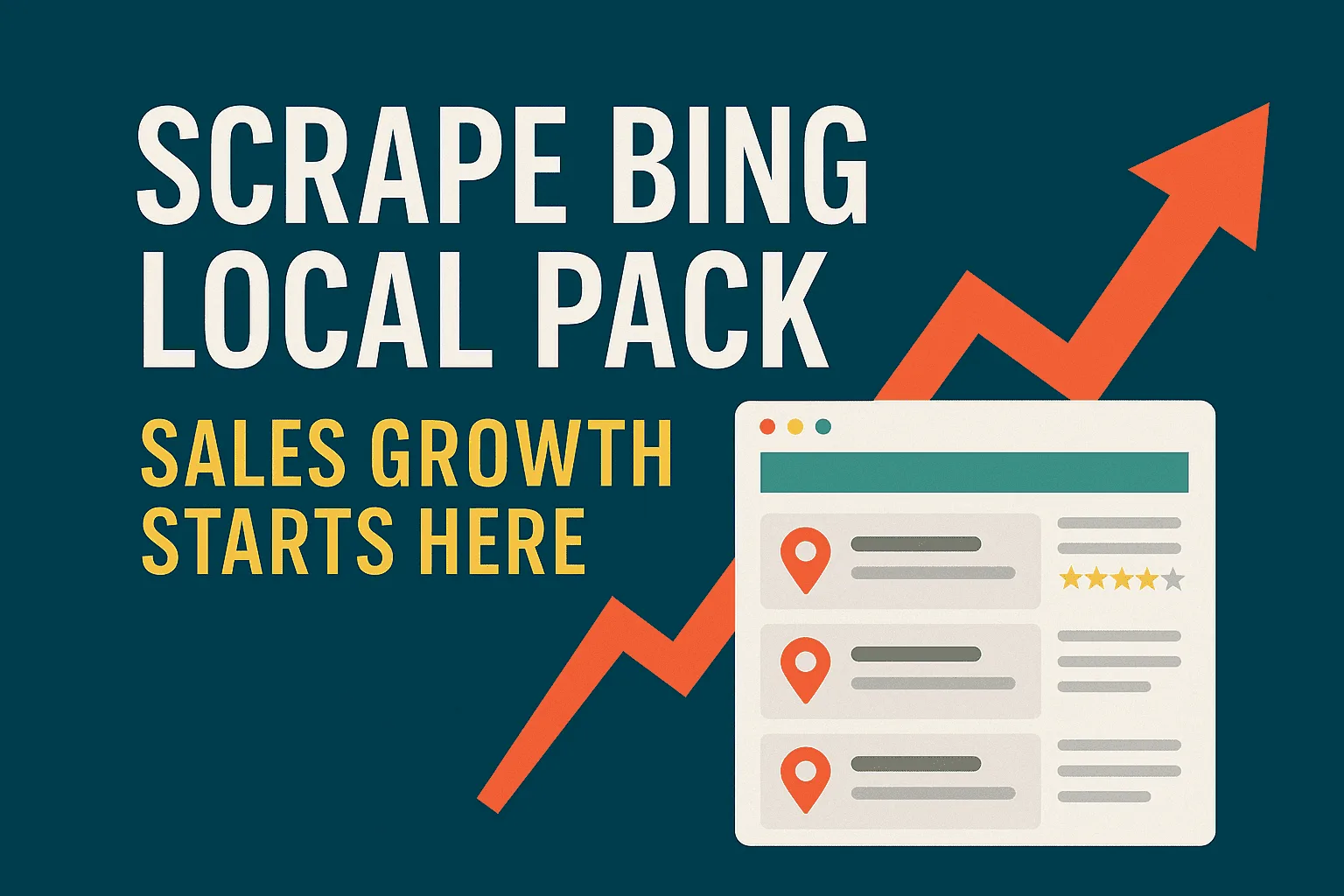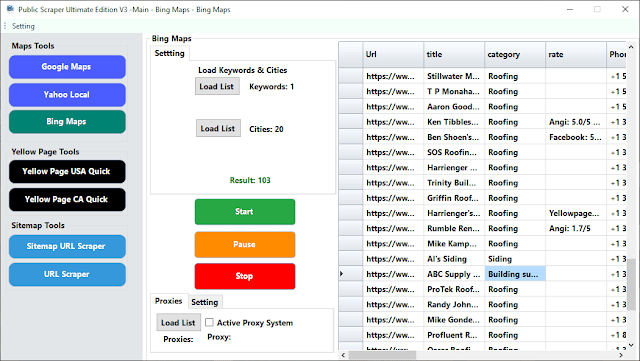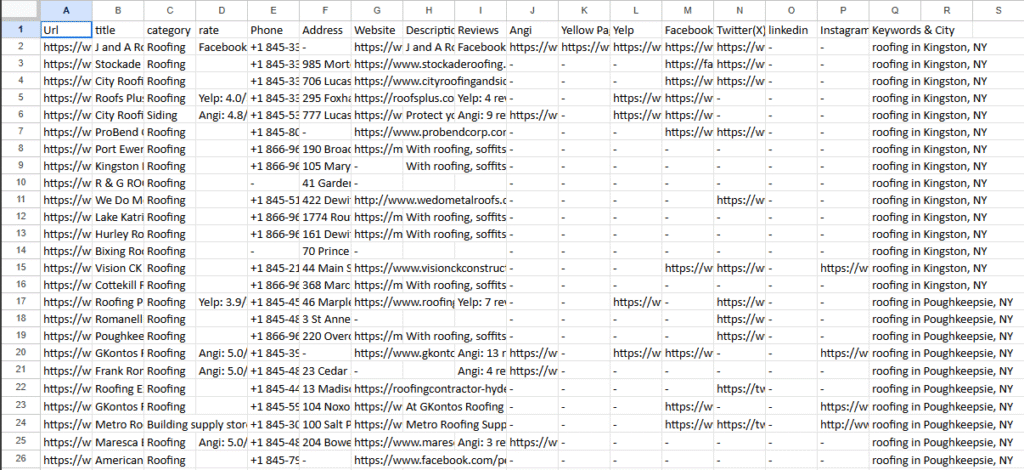Why sales teams scrape bing local pack for targeted outreach
Sales teams scrape bing local pack to quickly discover nearby, high-intent businesses that match their ideal customer profile. Because those listings show companies that already rank for relevant searches, the data is fresh and commercially oriented. As a result, reps can build targeted lists in minutes, not days. And with a bing maps scraper, they can turn messy map results into clean, usable records for outreach.

What exactly is the Bing Local Pack?
Before we jump into tactics, let’s align on terms. The “Local Pack” is the 3–4 business results that appear in Bing’s map module for location-based searches like “plumber in Dallas” or “marketing agency near me.” Each result typically shows a business name, rating, address, phone number, hours, and a link to the website or Bing Places profile.
Because the Pack surfaces when buyers have intent, these listings are a goldmine for outbound. Moreover, they’re clustered by geography and category—two filters sales teams already use.
The playbook at a glance
- Define the niche: industry + location.
- Generate search intents and modifiers.
- Use a bing maps scraper (or manual methods) to extract results.
- Normalize and enrich the data.
- Prioritize with simple scoring.
- Personalize outreach with Local Pack context.
- Track replies, refine queries, and scale.
Next, let’s break down each step, with practical details your team can follow today.
1) Nail your ICP and geo targets
Start simple. Who buys from you, and where? For example:
- Niche: dental clinics with 3–15 employees.
- Location: Phoenix metro and nearby suburbs.
- Buying trigger: clinic promotes aligners or cosmetic services.
Then, write problem-aware queries a buyer would search. For instance:
- “dentist Phoenix”
- “cosmetic dentistry Phoenix”
- “invisible braces Gilbert”
Small change, big impact: move from “broad category + city” to “service + neighborhood.” This shift often exposes new pockets of prospects the generic terms miss.
2) Build an intent list you can reuse
Create a spreadsheet with two columns:
- Service modifiers: emergency, 24/7, cosmetic, pediatric, eco, premium, budget, near me.
- Geo modifiers: city, suburb, neighborhood, landmark, ZIP.
Now, combine them. For example:
“emergency plumber Tempe,” “pediatric dentist Chandler,” “SEO agency Plano.”
Because intent + geo equals Local Pack visibility, these combos help you reach the right buyers, in the right places.
3) Extract results: manual vs. bing maps scraper
You have two options.
Manual (good for testing):
Search Bing with your intent phrase. Open the map module. Expand results. Copy business names, websites, and phone numbers into your sheet. This is slow but useful when you’re validating a niche.
Automation (best for repeatable outreach):
Use a bing maps scraper to scrape bing local pack results at scale. A capable tool will:
- Steps to Use Bing Maps Scraper
- Load your keywords
Add the business type or service you’re targeting (e.g., “plumbers,” “coffee shops,” “lawyers”). - Load your locations
Choose cities, regions, ZIP codes, or even specific neighborhoods. - Enable proxy (optional)
Turn on proxy rotation to avoid IP blocking and scrape multiple locations safely. - Press start
Launch the scraper and watch results appear in real time. - Export your data
Save results as CSV, XLSX, or JSON and plug them directly into your CRM, spreadsheet, or analysis tools.

Data You Can Extract
- Business name / title
- Category or industry
- Full address (street, city, state, ZIP, country)
- Phone number
- Website URL
- Ratings & review counts
- Opening hours
- Short business description (when available)
- Social links (Facebook, LinkedIn, Instagram, YouTube, etc. – if listed)
- Mentions on third-party directories (Yelp, Yellow Pages, Angi, etc.)
- Custom notes or tags (like service keywords per city)

Tip: run your first scrape with 5–10 intent phrases and one metro area. Then review the output for quality before scaling.
4) Clean, normalize, and enrich the data
Raw map data needs polishing. Fortunately, this is quick work if you follow a checklist.
Normalization:
- Split “Full Address” into Street, City, State/Region, ZIP.
- Standardize phone numbers to E.164 (e.g., +1 555-555-1234).
- Unify categories (e.g., “Dental Clinic,” not “Dentist,” “Dentistry,” “Dental Office”).
Deduplication:
- Match on domain + phone first.
- Then fuzzy-match business names within the same city (e.g., “Smile Co” vs. “Smile Company”).
Light enrichment (optional but helpful):
- Pull homepage title/description for quick personalization cues.
- Use review count and rating as a “social proof” signal.
- Tag whether the listing shows “Open now,” “Closes soon,” or “24 hours.”
- Note site tech hints visible on the homepage (e.g., “Book now” widget, CMS).
Because these fields connect directly to pain points (“you’ve got reviews but no booking CTA”), they raise reply rates.
5) Score and segment to focus your reps
Not all leads deserve equal attention. A simple scoring model helps:
Example scorecard (0–10):
- Review volume (0–3): 0 = none; 3 = 50+
- Rating (0–2): 0 = <3.5; 2 = ≥4.5
- Website present (0–1)
- Category fit (0–2): exact match gets 2
- Geo fit (0–2): high-priority ZIPs get 2
Then segment:
- A-list: 8–10 points → 1:1 personalized emails + warm calls
- B-list: 5–7 points → light personalization + email sequence
- C-list: <5 points → lower-touch drips or hold for future campaigns
Because this model is transparent, reps can tweak weights without breaking your process.
6) Craft messages that reference the Local Pack
Personalization wins when it’s specific and relevant. Therefore, use Local Pack context to prove you did your homework.
Cold email framework (short and human):
- Subject: Quick idea for {{City}} visibility
- Line 1: “Saw you in Bing’s Local Pack for ‘{{query}}’—nice placement.”
- Line 2: “Noticed {{specific detail: review count, hours, or missing CTA}}.”
- Line 3: “We help {{industry}} convert map views into booked appointments.”
- CTA: “Open to a 7-minute audit this week?”
Because the email references the exact query and a visible detail, it feels real—never canned.
Call opener:
“Hey {{Name}}, quick one—I found {{Business}} in Bing’s map results for ‘{{query}}.’ Congrats on the rank. Are you actively trying to turn those map views into calls? I noticed {{specific detail}} and thought I’d share two fast wins.”
7) Sequence and follow-up without being spammy
Use a 5-touch sequence over 10–14 days. Keep it respectful and useful.
- T1 (Day 1): The personalized email above.
- T2 (Day 3): A second email with one screenshot or 15-second Loom showing the listing and a clear fix.
- T3 (Day 5): Light call. Ask one diagnostic question.
- T4 (Day 9): Case-style email: “How a {{industry}} in {{city}} turned map views into 23 booked calls/month.”
- T5 (Day 14): “Close the loop” email with a simple yes/no CTA.
Because each touch adds value, you’ll earn replies without burning your domain reputation.
8) Common pitfalls (and how to avoid them)
- Over-broad queries. “Dentist Texas” is too wide. Instead, use specific services + neighborhoods.
- Dirty data. Unclean phone numbers and duplicate domains waste rep time. Normalize first.
- No prioritization. If everyone is “hot,” no one is. Score and segment.
- Flat messaging. “We do marketing” is ignorable. Reference the exact Local Pack context you found.
- Ignoring compliance. Always review the website’s contact policy and Bing’s terms. Use respectful sending volumes and opt-out links.
9) Advanced tactics to level up
Cluster by micro-location.
Group leads by 3–5 mile radius. Then offer a “local domination” angle, like “Win the Pack in Arcadia and Biltmore first.”
Spot weak rivals.
If your scrape shows several low-review competitors in one neighborhood, call that out: “You’re one review burst away from owning this Pack.”
Timing around hours.
Listings with “Open now” during off-peak hours may rely on phone calls. Therefore, suggest call tracking or a faster booking flow.
Surface quick wins.
If the site has no click-to-call on mobile or buries the address, mention it. “Two quick tweaks to capture more map traffic.”
Bridge to ads or CRO.
Once you fix the basic visibility gaps, propose a small paid test targeting the same queries. Or, improve the booking experience to turn more map clicks into revenue.
10) Tools checklist (keep it lean)
You don’t need a giant stack to start. However, a few tools make life easier:
- Bing search and maps for discovering Local Pack results.
- A reliable bing maps scraper to export CSVs from multiple queries.
- Spreadsheet or lightweight CRM (Airtable, HubSpot Free) for cleaning, scoring, and tracking.
- Warm-up + send platform for sequences and deliverability basics.
- Call notes app (or your CRM) to capture objections and wins.
Start small. Then standardize what works.
11) Measuring success and iterating
Track four simple metrics:
- List yield: leads per query. Improve with better modifiers.
- Validity rate: working phones/websites. Improve with normalization.
- Reply rate: aim for 10%+ on A-list batches. Improve with deeper Local Pack references.
- Booked calls / deals: the only metric that matters long term.
Then, run weekly reviews:
- Which intents produced the most A-list leads?
- Which neighborhoods converted best?
- Which personalization cues landed replies?
- What should we stop doing next week?
Because the Local Pack is dynamic, this loop keeps you aligned with live demand.
12) Responsible scraping and compliance
A quick note. Always respect the terms of service for the sites you interact with, and follow local laws on data use and outreach. Include a clear opt-out in emails. Moreover, send at humane volumes and avoid deceptive tactics. Sustainable outbound beats “blast and pray.”
Public Scraper Ultimate
- All-in-one scraping suite combining 7+ powerful tools:
- Bing Maps Scraper
- Yahoo Local Scraper
- Yellow Pages USA Scraper
- Yellow Pages Canada Scraper
- Sitemap Scraper
- URL Scraper
- (and more add-ons)
- Modern, user-friendly interface—no coding required.
- Run bulk keyword + city scrapes or schedule recurring jobs.
- Built-in deduplication and enrichment (validate websites, categories, and data).
- Export in multiple formats: CSV, XLSX, JSON, or sync to Google Sheets/webhooks.
- Dashboards for progress tracking, logs, and error reporting.
- Proxy rotation and automation support for stable, large-scale operations.
- Weekly updates, active maintenance, and responsive customer support.
Example workflow you can copy today
- Pick one metro area and one niche.
- List 10 intent phrases (service + neighborhood).
- Run those through your bing maps scraper and export a CSV.
- Clean and deduplicate.
- Score leads, then pick the top 50.
- Write five personalization snippets using Local Pack details.
- Launch a 5-touch sequence over 14 days.
- Log outcomes. Adjust your intents next week.
Because this process is compact, you can run it in under a day and improve it every week.
Final thoughts
Scraping the Local Pack isn’t just a data task. It’s a way to meet buyers where they already show intent. When you scrape bing local pack results with purpose, clean the output, and speak to what you see—reviews, hours, nearby competitors—you turn map visibility into conversations. And with a lightweight bing maps scraper and a repeatable workflow, your team can scale targeted outreach without losing the human touch.
In short, start narrow, personalize deeply, and iterate fast. Your calendar—and pipeline—will show the difference.
Leave a Reply